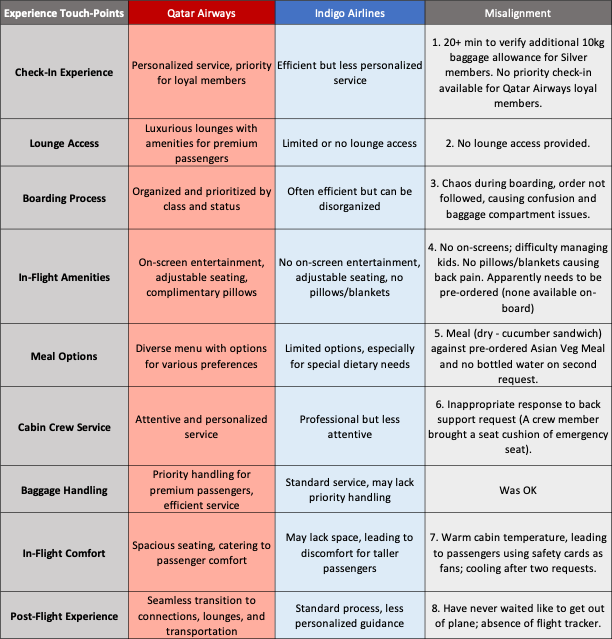Customer Experience Turbulence: How My Qatar-Indigo Code-shared Flight Experience Revealed a Misalignment in Strategic Alliances
How do brands align in strategic partnerships in an era where customer experience defines success? My recent flight with Qatar Airways-Indigo's code-share alliance unraveled a glaring inconsistency, revealing a critical lesson in brand integrity and customer expectations. Join me in exploring this crucial aspect of modern business collaboration.
Customer experience at the forefront of strategic alliances
In today's consumer market, where customer-centricity shapes business success, aligning brand values in strategic partnerships is paramount. The symbiotic relationships between airlines through code-share agreements have been a testament to this trend. Yet, my recent flight experience with Indigo Airlines, as a code-share partner of Qatar Airways, reveals a glaring flaw in strategy, leaving me disappointed, uncomfortable, and questioning the integrity of the alliance. I decided to write an article as it provides an invaluable case study on the importance of maintaining brand integrity, customer expectations, and my insight into the ever-evolving landscape of customer experience.
The customer experience chasm: How an unpleasant experience unfolds
An Illusion of Uniformity
As a silver member of Qatar Airways, I boarded the Indigo flight expecting the same level of continuity in service quality I had always enjoyed with Qatar. But right from the outset, my experience began to unravel, eroding the experience that had been the hallmark of Qatar Airways. From questioned privileges to disorganized boarding and inadequate meal offerings to uncomfortable seating, the experience was marred by inconsistencies, disappointments, and a lack of empathy.
Customer experience management is not just about meeting expectations but about exceeding them. Today, a traveler like me seeks continuity in the quality, service, and brand promise. Unfortunately, after paying for services to Qatar Airways, my experience as a passenger on an Indigo flight under the code-share partnership with Qatar Airways exposed significant disparities in service.
Qatar Airways has long been recognized for its premium offerings, and its standard offering is above industry standards. Its flights, facilities, personalized services, gourmet dining, and essential to premium inflight experiences have garnered a reputation for excellence. Conversely, Indigo Airlines has built its brand around efficiency, affordability, and reliability.
At the same time, it works for domestic flights in India; this positioning contrasts sharply with the premium experience that Qatar's loyal customers have to expect for an international flight experience. The misalignment between these two different brand philosophies became evident during my flight. Therefore, there is a significant risk of diluting the brand value through misaligned partnerships.

The code-share partnership between the two airlines brought into sharp focus the inherent risk of aligning two fundamentally different service models. Qatar Airways, known for its premium positioning, failed to align its brand values with Indigo, a non-premium service provider. The resulting incongruity eroded trust and tarnished the customer experience.
Although code-share agreements can broaden networks and provide customers with more options, they must be executed with a careful evaluation of brand alignment/compatibility. My experience with another partner, such as British Airways, was very good and equal.
Brand alignment: Qatar's Premium vs Indigo's Non-Premium PositioningThe bedrock of successful partnerships
Brand alignment is more than a business strategy; it's a leadership commitment to ensuring that partnerships reflect and reinforce the core values and promises that define a brand. The mismatch between Qatar's premium service and Indigo's affordability-focused approach serves as a poignant example of the challenges that ill-aligned partnerships can present.
We must recognize that every partnership is an extension of the brand. An inconsistent partnership can lead to confusion, disappointment, and losing loyal customers.
Navigating the customer experience landscape: From Disappointment to DelightLeading with Empathy and Insight
The insights gained from this experience are not just relevant to airlines but extend to all industries where customer satisfaction and engagement are paramount.
Personalization and Expectation Management: Meeting customer expectations requires a nuanced understanding of the segments - preferences, needs, and anticipation throughout the journey. A silver member's privileges should be acknowledged, not questioned, demonstrating respect for loyalty.
Catering to Diverse Needs: From the inflight meal to amenities, catering to the diverse needs of customers is crucial. It demands foresight, empathy, and willingness to go the extra mile. I cannot believe the fact that there was no pillow on the Indigo Airlines flight, which is a basic need for travel comfort.
Organization Efficiency: Smooth boarding processes, efficient luggage handling, and clear communication are non-negotiable aspects of a delightful travel experience. Disorganization can lead to customer dissatisfaction and adversely impact brand reputation.
Leadership in customer experience is about empathy, foresight, and strategic alignment. It's about seeing the customer journey as a series of touchpoints and an orchestrated symphony where every interaction matters, especially in a partnership where the same experience should be guaranteed, as the touchpoints are constant.
Therefore, the experience emphasizes that strategic partnerships must be approached with discernment, aligning not only with business objectives but also with the brand's core values and customer experience philosophy.
A vision for the future of customer experience and a call for strategic alignment in partnerships
Conclusion
The partnership between Qatar Airways and Indigo Airlines offers rich lessons in brand alignment, strategic thinking, and customer-centric leadership. By understanding customer journeys, recognizing the brand values, and approaching partnerships with wisdom and insights, businesses can forge alliances that resonate with customers, enhance reputation, and foster a harmonious customer experience.
In today's world, where customer loyalty is gold and brand reputation is a fragile treasure, navigating strategic partnerships with wisdom and customer-centric focus and approach is not just a leadership skill but a strategic imperative.
Our ability to learn from such experiences and apply these insights will shape the future of customer experience, fostering trust, loyalty, and lasting success.
I would love to hear your thoughts on the role of customer experience in strategic partnerships. Have you encountered similar scenarios? Share your views or experiences in the comments below!



